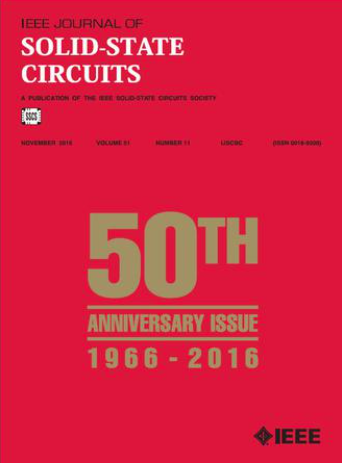生物医学用发光氧测量的非均匀采样寿命估计技术
IF 5.6
1区 工程技术
Q1 ENGINEERING, ELECTRICAL & ELECTRONIC
引用次数: 0
摘要
本文提出了一种不受偏移影响的新技术,可以精确测定发光材料的寿命。该技术专门用于测量经皮氧,这是一种通过皮肤扩散的氧气指标,反映动脉氧水平。与基于强度的测量不同,基于寿命的发光测量更优越,因为它们将氧信息与混杂因素分离开来。在这项工作中提出的技术包括测量固定电压步长之间的时间差,以提取衰减指数的时间常数,这代表了发光的寿命。我们提出了一种新颖的开关电容电路,使集成时间长,防止前端放大器饱和。模拟子系统采用180nm CMOS技术,通过增益带宽积为10mhz的跨阻放大器(TIA)、比较器和开关电容电路实现。未经后处理,测量平均误差可达1.9%。在$130~{\mu}$ s的测量周期内,每次计算${\text {FoM}_{W}}{=}177$ nJ/conv,读出电路最大消耗$16~{\mu}$ J。初步的人体试验表明,该传感器可以有效地检测由动脉闭塞引起的经皮氧水平的变化。本文章由计算机程序翻译,如有差异,请以英文原文为准。
A Nonuniform Sampling Lifetime Estimation Technique for Luminescent Oxygen Measurements for Biomedical Applications
This article presents a novel technique that is immune to offset, enabling precise determination of the lifetime of luminescent materials. The technique is specifically applied to measure transcutaneous oxygen, an indicator of oxygen that diffuses through the skin and reflects arterial oxygen levels. Unlike intensity-based measurements, lifetime-based luminescence measurements are superior because they decouple oxygen information from confounding factors. The technique presented in this work involves measuring the time difference between fixed-voltage steps to extract the time constant of a decaying exponential, which represents the lifetime of luminescence. We propose a novel switched-capacitor circuit that enables long integration times and prevents the front-end amplifier from saturating. The analog subsystem was realized in 180-nm CMOS technology via a transimpedance amplifier (TIA) with a gain bandwidth product of 10 MHz, a comparator, and a switched capacitor circuit. The measured mean error is as accurate as 1.9% without postprocessing. During a $130~{\mu }$ s measurement period, the readout circuit consumes a maximum of $16~{\mu }$ J per calculation with a ${\text {FoM}_{W}}{=}177$ nJ/conv. Preliminary human subject tests have demonstrated that the sensor can effectively detect changes in transcutaneous oxygen levels resulting from arterial occlusion.
求助全文
通过发布文献求助,成功后即可免费获取论文全文。
去求助
来源期刊

IEEE Journal of Solid-state Circuits
工程技术-工程:电子与电气
CiteScore
11.00
自引率
20.40%
发文量
351
审稿时长
3-6 weeks
期刊介绍:
The IEEE Journal of Solid-State Circuits publishes papers each month in the broad area of solid-state circuits with particular emphasis on transistor-level design of integrated circuits. It also provides coverage of topics such as circuits modeling, technology, systems design, layout, and testing that relate directly to IC design. Integrated circuits and VLSI are of principal interest; material related to discrete circuit design is seldom published. Experimental verification is strongly encouraged.
 求助内容:
求助内容: 应助结果提醒方式:
应助结果提醒方式:


